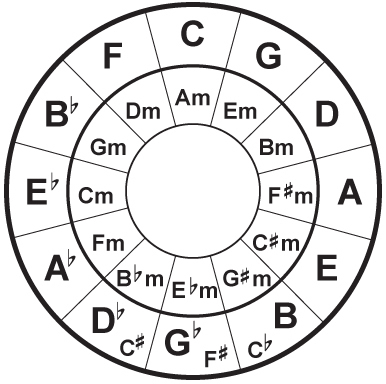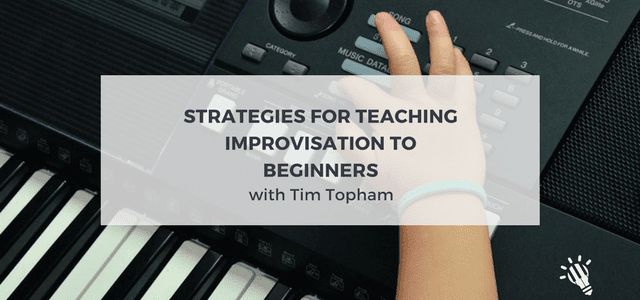Ever wondered how to approach teaching students basic non-jazz improvisation?
We know that as teachers, in order to provide our students with a holistic musical education, we should be incorporating aural, theory, sight-reading, general knowledge, composition and improvisation into our lessons on a regular basis. However for many teachers, it’s hard to know where to start… or where to find the time!
Paul Harris really got me thinking about this recently through his concept of Simultaneous Learning – I highly recommend reading this article if you’re unfamiliar with the concept.
Put simply, if you compartmentalise all the above aspects of your lesson, you’ll never have time to do it all. Instead, Harris recommends finding all the connections between these areas and integrating them regularly into everything you do in your lessons. His book Improve Your Teaching explains it in detail and is highly recommended resource for teachers. I shall be blogging about my own experience with Simultaneous Learning in the near future.
Recommended: How to get your beginner students composing music
I’m a huge believer in the importance of teaching improvising to students from as early as possible in their music education. It’s a fundamental musical skill that is fun and helps develop an innate understanding of:
Best of all, students don’t need to be able to read a note to do it, which 
Please note that for the purposes of this post, I’m talking about non-jazz improvising. We all know that students can readily improvise using a blues scale over a blues or boogie pattern, but what about composing music more in line with film music, ballads, pop and classical?
Many of you will be familiar with the image to the right, called the “Circle of 5ths“. Do you use it in your teaching? Do you get students to work around the circle when learning scales and/or chords? Perhaps you have it on the wall for quick reference to keys, related scales and key signatures.
I believe the most musical use of the circle is in teaching students about harmony and chord progressions. Most of you will teach students about the primary triads (I, IV, V) in some way. Perhaps students learn about the 12-bar blues progression (see my previous post “Teaching 12 Bar Blues to inspire beginners”) which uses only the primary triads, or maybe they study them as part of their theory instruction.
Whatever the method, learning the primary triads in any given key is really useful because:
Take a composition in the key of C. Centre yourself around C on the Circle of 5ths and you’ll find that one chord to the right is the V chord (G); one chord to the left is the IV chord (F). The secondary triads (relative minors) are inside the circle: A, Em and Dm. Together, these six chords can create quite substantial compositions.
Whenever my students start a new piece, I drill them on the chords they are likely to find in the piece using their understanding of the Circle of 5ths. Students quickly realise the importance of the relationship between the chords and are able to accurately guess the chord progressions they are likely to find in their pieces. This of course, makes reading the music much easier as they are already looking for structures and shapes they understand.
So with all that in mind, here’s a video of how I introduce improvising to my students:
If this is not the sort of thing you usually do with your students, then I hope you’ll give it a try.
If you’d like me to post more ideas, please leave a comment with your questions.
Looking for some more inspiration to get your students improvising? Check out my trusty 12 Bar Blues course to get your students improvising in more styles and of course, having fun while doing it.

Creating a Toolbox for Musical Improvisation - Tonara says:
[…] musical improvisation isn’t about forming a structured learning technique, but finding a way to incorporating aural, theory, sight-reading, general knowledge, composition, and improvisation into lessons […]
Pilar says:
Hi Tom! I have followed your posts lately because I need teaching resources to make every piano class, a learning and a joyful experience for each student. I am teaching beginning piano to students from 4 to 18 years old. It has been a real challenge to teach the little ones. I Have enjoyed every single post of yours. Thank you so much for your valuable experience and knowledge you have shared until now.
Tim Topham says:
Thanks Pilar! Glad you’ve found the resources useful. Make sure you check out my membership at topmusic.co/community – sounds like you’d get lots of great value and benefits 🙂
32 Quick & Easy Ideas for Piano Improv and Composing says:
[…] Teach your students how to improv with the help of Tim Topham’s strategies for teaching beginners improv […]
Hannah says:
Hi there,
I really enjoyed your blog and want to learn more about this teaching style. However the URL for the YouTube video is not working. Could you send me the YouTube video about teaching with the circle of fifths and improvising in that manner? Thanks so much for your help! I’m excited to learn more about this.
Tim Topham says:
Hi Hannah – thanks for alerting me to the dodgy video! I’ve updated it so you can now see it 🙂 You may also like my teaching videos on 12 Bar Blues and chords. eg. topmusic.co/chords.
Hannah says:
Hi,
I was just wondering- if I were to teach beginner students for the first time, what should I teach them? Should I start with counting, then move on to note reading, then chords? Or note reading first? Which progression do you think works best to help facilitate learning?
Thanks!
Tim Topham says:
Hi Hannah – it’s a great question and one that I’ll be answering with the launch of my No Book Beginners course next week! Make sure you’re on my email list and you’ll get notified.
If anyone is reading this after 27 March 2017, then please search the blog for beginners and you should find it 🙂
TTTV001: Student composition tactics with Daniel McFarlane - topmusic.co says:
[…] Strategies for Teaching Improvisation to Beginners […]
Brian Goddard says:
Tim, I have never been able to follow properly all the books I have in improvising, but feel I will get somewhere starting with your system. Do you have some follow on instruction? I am semi-retired but have four students and intend instructing them on your system of improvising, i.e. starting with the circle of fifths. Thank you for including this, which I first saw in issue 1 2013 Piano Perspectives.
Can Tetris help your sight-reading? | Tim Topham says:
[…] the “root-5-root” pattern so common to modern film and pop music (and that I use for composition work with my teen and adult students), which is just an octave with a 5th in the […]
timtopham says:
Hi Qing. I don’t really have time to teach you how to improvise sorry. I would check out all my articles about teaching improvisation (there is a few on the blog), search for similar articles on Google and if you like jazz piano, check out jazz piano teaching sites on the web. Where are you based?
Qing says:
Thanks a lot, Tim.
Your article and video is so helpful.
I learnt piano for many years, but even don’t know how to improvise a “Happy Birthday”. I would like to self-teach improvisation more. Could you give me more instruction, such as where and how to start.
Sarah Carlson says:
After watching you video (very nice, by the way), I have a question. What are the rules of chord progressions? You gave I — IV — I — V. I know there are many more but is there incorrect progressions students should be aware of? I remember learning about rules of what chord can go to what cord in college music theory in college but can’t remember. Thanks.
timtopham says:
Hi Sarah! Thanks so much for your comments – it’s great to hear that you’ve got so much out of my post. There aren’t any hard and fast rules of chord progressions – I like the students to use their ears to find out what works and what doesn’t. We tend to start on a I – IV – V – I progression (note that it’s a bit different to what you wrote) and giving them an understanding that you need to start and end on I and the second last chord should be a IV or V (to give you a strong cadence). Really everying in the middle is up to them (ie. using the relative minor chords ii, iii and vi).
They tend to realise quickly that going I – ii – iii – IV – V isn’t a strong progression but I – iii – IV is good. I like them to listen and use their ears rather than proscribing anything or saying that it’s “wrong” – it’s just that some are better than others.
Hope that helps,
Tim.
Sarah Carlson says:
Thanks, Tim. I appreciate your response. It does help! I’m putting together a handout for my students outlining composing and chord progression guidelines. I appreciate the information you have shared.
Sarah Carlson says:
Tim, this was such a helpful article! Thank you so much. I have been trying the 12-bar blues improv tips you gave in another article with some of my boy students and their response has been so positive I can’t wait to try it with more students! I’ve been teaching “chording” to my students for several years now but am only recently seeing how it can connect to composing. Thanks for pointing out that the V chord is to the right of the I chord and the IV chord is to the left on the circle of fifths. I never noticed that before and that will be very helpful to point out to my students! Thanks a ton!
Chrissa Brown says:
Great article, Tim. I love improvising but as it’s something I never actually ‘learnt’ I’ve found it a bit trickier in trying to actually teach it to my own students! So thanks for this – very helpful.
timtopham says:
Hi Chrissa – thanks for the feedback and glad you found it interesting 🙂